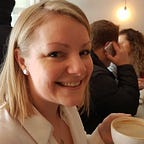Why we’re doing a discovery into community resilience at British Red Cross
My team at British Red Cross (BRC) has just started a discovery into community resilience.
In short we’re spending 12 weeks understanding people’s unmet needs to prepare, respond and recover from emergencies. Emergencies like the Cumbria floods in 2015 and the devastating fire at Grenfell Tower in June 2017.
Our goal is to identify practical things BRC should do to meet the needs of people affected by emergencies.
The team and I will be blogging about this work as we do it. To start I wanted to quickly say how this work started and why we’re doing it.
How this work evolved
2017 was an unprecedented year for the UK and for BRC in terms of emergencies. The impact of those emergencies extended beyond those who tragically lost their lives, to survivors, bereaved families and affected communities who were forced to adapt to a new reality.
Through the devastation of emergencies, this period also showed the power of human kindness in the way communities mobilised to respond and support those affected. This enabled a more local and culturally sensitive response and recovery process. Recognising that people should be supported as locally as possible in the preparation, response and recovery from emergencies, we want to learn more about what community resilience is, and how it can contribute towards meeting people’s unmet needs.
This works builds particularly on two of the principles set out in BRC’s Harnessing the power of kindness for communities in crisis report:
- Principle 1: People should expect that their crisis needs are central to the way emergency response is designed and implemented, wherever they are in the UK;
- Principle 8: Following an emergency, communities should be supported to recover and become stronger and more resilient to crisis in the future.
We started with a brief to look at how we support the voluntary and community sector to respond to a crisis. However, we quickly realised that we needed to look more broadly at people’s unmet needs in order to identify where BRC is best placed to support.
Building on existing knowledge
We’re starting from a great place. In 2018 BRC responded to a whopping 1400 emergencies, helping over 9000 people. Our unique role as a humanitarian auxiliary to government means that we were called upon to respond in Manchester and London during the emergencies in 2017, one of the only organisations to respond to all the events taking place.
This operational insight has allowed us to learn loads from colleagues across the BRC. They’ve shared expertise and knowledge about responding to people’s needs before, during and after emergencies. This has really helped us understand the wider context of the service design work and what impact we hope to have.
But now is the time we need to learn from people who have experienced emergencies to understand their unmet needs to prepare, respond and recover. This is the focus of our discovery.
What actually is a “discovery”?
A discovery is the first stage of service design. It is taking time to first explore a problem space. To understand the needs of the people who will use and help deliver your service.
For our team that means understanding the unmet needs of people who have experienced emergencies like fires and flooding. It also means understanding the needs of community groups, volunteers and frontline workers who respond in these emergency situations.
A discovery involves interviewing lots of people, asking open questions and learning what you didn’t expect to find out. Then, through analysis of the findings, spotting common problems we could potentially try and solve later on.
A discovery is about reducing risk
Understanding needs first reduces the risk of building services that people don’t use, want or that aren’t impactful.
A good discovery tests an organisation’s assumptions about the problems people have, what motivates them, what they care about most and what problems, if solved, will have the most impact on their lives.
Finding all this out will help us to identify which problems to focus on. In particular which problems BRC is best placed to try solving with people.
Getting first hand experience
While we’re building upon existing knowledge, we also wanted to go out as a team and learn about people’s unmet needs first hand. We’re doing this for a few of reasons:
- Building empathy with our users and the problems they face
- Ideas are arguably best stimulated by directly seeing and hearing people’s problems
- By understanding problems in enough detail we can make practical design decisions.
Making informed design decisions
Doing a discovery is about learning enough to start designing a service. Being confident enough to make informed first design decisions. Key design decisions such as: what should our service do; who needs to use it; what value does it offer to people and; how do we make that value obvious to people?
When we’ve learnt enough that we feel confident trying to make these decisions, we’re ready to move out of discovery.
Next steps and what follows a discovery
We’ve already started interviewing people and are planning more interviews around the UK with people who’ve experienced fires or flooding, as well as community groups and frontline workers who respond in emergencies. Keep an eye out for blog posts on all the different things we’re learning.
This discovery is the first stage of designing a service. After that is the ‘alpha’ stage. More soon on what we’re learning and how we are approaching the project.
